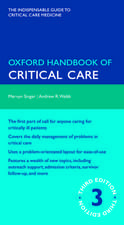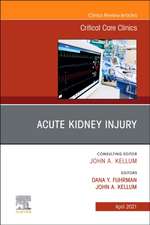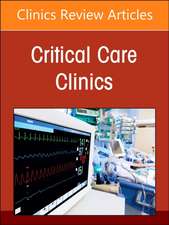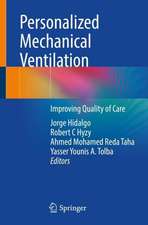Infectious Diseases and Antimicrobial Stewardship in Critical Care Medicine
Editat de Cheston B. Cunha, Burke A. Cunhaen Limba Engleză Hardback – 13 iul 2020
This new edition features chapters that explain the tenets of differential diagnostic reasoning, differential diagnostic characteristics of fever patterns in the CCU. The proper interpretation of rapid diagnostic tests, in the appropriate clinical context, is included. The diagnostic importance of cardinal clinical findings, particularly when combined, in the appropriate clinical context is emphasized and remains the basis for clinical problem solving in the CCU. Uniquely, critical diagnostic physical findings in the CCU, including color atlas of diagnostic eye findings, are included as important diagnostic determinants in the CCU.
Written by infectious disease clinicians for CCU consultants, Infectious Diseases and Antimicrobial Stewardship in Critical Care Medicine 4E remains a useful evidence based and experience tempered key clinical resource for infectious disease problems in the CCU.
Key Features
- Essentials of the tenets of clinical diagnostic reasoning is explained as it relates to formulating a rapid and accurate clinical syndromic diagnosis in the CCU
- The diagnostic significance of fever patterns and their relationship to the pulse rate in the proper clinical context is explained in depth as related to the CCU setting
- Formulating an accurate early clinical syndromic diagnosis is presented as essential since it is the basis of effective empiric antibiotic therapy in the CCU
- How to combine key non-specific laboratory and imaging findings to increase diagnostic specificity and diagnostic probability in the CCU is presented
- Clinical perspective on the proper interpretation of the clinical significance of rapid diagnostic test results in the CCU is included
- A clinical approach to apparent "antibiotic failure" in the CCU is presented either due to actual antibiotic failure or seeming but unrelated non-antibiotic failure
- Section focuses on the practical aspects of antimicrobial stewardship particularly as related to optimizing dosing effectiveness while minimizing resistance and adverse effects in the CCU
| Toate formatele și edițiile | Preț | Express |
|---|---|---|
| Paperback (1) | 733.60 lei 6-8 săpt. | |
| CRC Press – 13 iun 2022 | 733.60 lei 6-8 săpt. | |
| Hardback (1) | 1083.36 lei 6-8 săpt. | |
| CRC Press – 13 iul 2020 | 1083.36 lei 6-8 săpt. |
Preț: 1083.36 lei
Preț vechi: 1303.90 lei
-17% Nou
207.30€ • 216.44$ • 171.57£
Carte tipărită la comandă
Livrare economică 05-19 aprilie
Specificații
ISBN-10: 1138297062
Pagini: 494
Ilustrații: 150 Illustrations, color
Dimensiuni: 210 x 280 x 29 mm
Greutate: 1.66 kg
Ediția:4th ed
Editura: CRC Press
Colecția CRC Press
Public țintă
Professional ReferenceCuprins
Notă biografică
Burke A. Cunha, MD, MACP is Chief, Infectious Disease Division at NYU Winthrop Hospital, Mineola, New York and Professor of Medicine, State University of New York School of Medicine, Stony Brook, New York. He is one of the world’s leading authorities on antimicrobial therapy and clinical infectious diseases. He has written/edited 1355 articles, 221 book chapters, and 36 books. He has received numerous teaching awards, including the Aesculapius Award for teaching excellence and the Spatz Award for clinical excellence. Dr. Cunha is a Master of the American College of Physicians, awarded for lifetime achievement as a Master Clinician and Master Teacher.
Descriere
Infectious Diseases and Antimicrobial Stewardship in Critical Care Medicine 4E has been fully updated and revised. The clinical diagnostic approach to common infectious disease problems in the CCU is the underlying theme in the book. Emphasized throughout is the importance of formulating an accurate early presumptive clinical syndromic diagnosis which is the basis for selecting optimal initial antimicrobial therapy in the CCU. Without an accurate presumptive clinical diagnosis, effective therapy is unlikely at best. Based on the most probable clinical diagnosis, optimal antibiotic empiric therapy, based on antimicrobial stewardship principles, minimizes resistance and antibiotic complications in the CCU.
This new edition features chapters that explain the tenets of differential diagnostic reasoning, differential diagnostic characteristics of fever patterns in the CCU. The proper interpretation of rapid diagnostic tests, in the appropriate clinical context, is included. The diagnostic importance of cardinal clinical findings, particularly when combined, in the appropriate clinical context is emphasized and remains the basis for clinical problem solving in the CCU. Uniquely, critical diagnostic physical findings in the CCU, including color atlas of diagnostic eye findings, are included as important diagnostic determinants in the CCU.
Written by infectious disease clinicians for CCU consultants, Infectious Diseases and Antimicrobial Stewardship in Critical Care Medicine 4E remains a useful evidence based and experience tempered key clinical resource for infectious disease problems in the CCU.
Key Features
- Essentials of the tenets of clinical diagnostic reasoning is explained as it relates to formulating a rapid and accurate clinical syndromic diagnosis in the CCU
- The diagnostic significance of fever patterns and their relationship to the pulse rate in the proper clinical context is explained in depth as related to the CCU setting
- Formulating an accurate early clinical syndromic diagnosis is presented as essential since it is the basis of effective empiric antibiotic therapy in the CCU
- How to combine key non-specific laboratory and imaging findings to increase diagnostic specificity and diagnostic probability in the CCU is presented
- Clinical perspective on the proper interpretation of the clinical significance of rapid diagnostic test results in the CCU is included
- A clinical approach to apparent "antibiotic failure" in the CCU is presented either due to actual antibiotic failure or seeming but unrelated non-antibiotic failure
- Section focuses on the practical aspects of antimicrobial stewardship particularly as related to optimizing dosing effectiveness while minimizing resistance and adverse effects in the CCU












